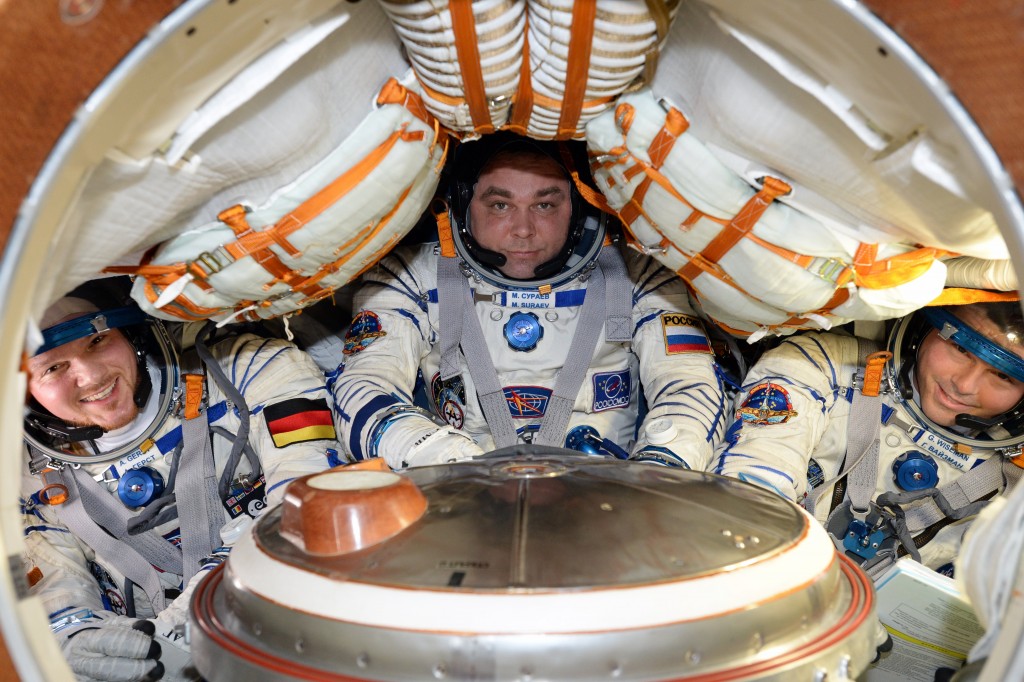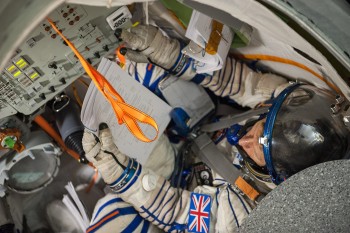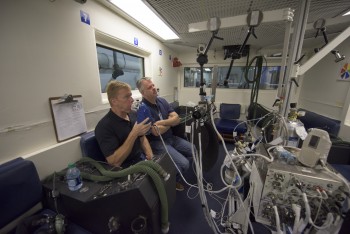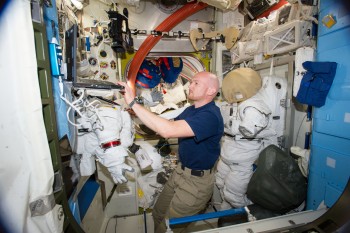
ESA astronaut Alexander Gerst, commander Max Suarev and NASA astronaut Reid Wiseman demonstrate the Soyuz tight-fit before their return flight to Earth in 2014. Credits: ESA/NASA
Although the Soyuz spacecraft is known for being a tight fit, mission control always manage to pack more equipment and spare parts to take to the International Space Station along with the three astronauts.
For Tim Peake, Tim Kopra and Yuri Malenchenko this is no different. They will be sharing their ride into space with a number of items stowed carefully above and around them. Personal items, last-minute spares and even scientific experiments can be included.
Interesting items on the Soyuz TMA-19M launch include new parts for ESA’s Airway Monitoring experiment. This experiment will see the two Tim’s enter the Quest airlock on the International Space Station to reduce the air pressure in the name of science.
Feeling the pressure
With each lungful of air, our bodies absorb oxygen and exhale waste-product molecules such as carbon dioxide and the important ‘signalling’ molecule nitric oxide. The Airway Monitoring experiment looks at the amount of nitric oxide the astronauts expelled by the astronauts in the airlock.
Nitric oxide is a gas found in cigarette smoke and car exhaust, for example, and it is produced in our bodies to regulate blood vessels and act as an antibacterial agent.
Doctors measure the amount of nitric oxide exhaled by patients to help diagnose inflamed lungs and asthma.
On Earth, dust drifts to the floor where vacuum cleaners or a damp cloth remove it easily. In weightlessness, dust circulates freely and often irritates and inflames eyes and lungs.
In addition, dust on the Moon and probably Mars sticks to astronauts through static electricity and has sharp edges – all making it more likely that dust will enter astronauts’ lungs and do harm.
The Airway Monitoring experiment will test the use of nitric oxide as a tool to monitor lung inflammation as well as charting lung health in astronauts.
Airway Monitoring 2.0
ESA astronaut Samantha Cristoforetti and NASA astronaut Terry Virts were scheduled for the first monitoring session in March 2015, however things didn’t go quite as planned – this experiment uses very complex sensitive sensors that have never been used in space before.
The team behind the experiment at the Karolinska Institutet of Sweden has slightly modified the sensors, reprogrammed the hardware and changed the instructions slightly for a second try with Tim and Tim.
In the Soyuz heading to space tomorrow, the team have packed new sensors that will allow them to continue running the experiment. Lars Karlsson is confident “We have taken all possible precautions”.
Currently the Airway Monitoring experiment is scheduled for February 2016. More technical information about this experiment can be found on ESA’s human spaceflight experiment archive.




Discussion: no comments